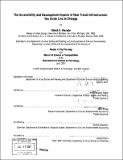| dc.contributor.advisor | P. Christopher Zegras and Mikel Murga. | en_US |
| dc.contributor.author | Warade, Ritesh K | en_US |
| dc.contributor.other | Massachusetts Institute of Technology. Dept. of Civil and Environmental Engineering. | en_US |
| dc.coverage.spatial | n-us-il | en_US |
| dc.date.accessioned | 2008-02-04T20:49:40Z | |
| dc.date.available | 2008-02-04T20:49:40Z | |
| dc.date.copyright | 2007 | en_US |
| dc.date.issued | 2007 | en_US |
| dc.identifier.uri | http://hdl.handle.net/1721.1/40130 | |
| dc.description | Thesis (M.C.P.)--Massachusetts Institute of Technology, Dept. of Urban Studies and Planning; and, (S.M. in Transportation)--Massachusetts Institute of Technology, Dept. of Civil and Environmental Engineering, 2007. | en_US |
| dc.description | Includes bibliographical references (p. 213-216). | en_US |
| dc.description.abstract | This thesis explores the impacts of new transit infrastructure projects on the land use transportation system. Land use and transportation systems are inherently interconnected and form an integrated system; and transport projects affect not just the transportation system, but also land use patterns. Current evaluation frameworks and models applied to new transport infrastructure projects usually focus on transportation system improvements, and so do not reflect the process of land use transportation interaction. To overcome this limitation, this thesis argues that the evaluation of transport projects should consider their accessibility and development impacts; and that this requires models which explicitly incorporate the interaction between land use and transportation. The Circle Line in Chicago is a proposed circumferential rail transit line which will serve the urban core of the Chicago region, and is likely to significantly affect both land use and travel patterns. | en_US |
| dc.description.abstract | (cont.) This thesis assesses how existing models can be used to quantify the accessibility and development impacts of this project; and how an existing evaluation framework, developed by the Federal Transit Administration, considers these impacts. In addition, this thesis develops a quasi-integrated land use transportation model for the Chicago region; and applies it to quantify the accessibility and development impacts of the Circle Line project. The frameworks and models developed for the Circle Line project provide an example of how to improve the current FTA evaluation methodology. | en_US |
| dc.description.statementofresponsibility | by Ritesh K. Warade. | en_US |
| dc.format.extent | 242 p. | en_US |
| dc.language.iso | eng | en_US |
| dc.publisher | Massachusetts Institute of Technology | en_US |
| dc.rights | M.I.T. theses are protected by copyright. They may be viewed from this source for any purpose, but reproduction or distribution in any format is prohibited without written permission. See provided URL for inquiries about permission. | en_US |
| dc.rights.uri | http://dspace.mit.edu/handle/1721.1/7582 | |
| dc.subject | Urban Studies and Planning. | en_US |
| dc.subject | Civil and Environmental Engineering. | en_US |
| dc.title | The accessibility and development impacts of new transit infrastructure : the Circle Line in Chicago | en_US |
| dc.type | Thesis | en_US |
| dc.description.degree | S.M.in Transportation | en_US |
| dc.description.degree | M.C.P. | en_US |
| dc.contributor.department | Massachusetts Institute of Technology. Department of Civil and Environmental Engineering | |
| dc.contributor.department | Massachusetts Institute of Technology. Department of Urban Studies and Planning | |
| dc.identifier.oclc | 187304784 | en_US |
